Aojun Zhou
MathCanvas: Intrinsic Visual Chain-of-Thought for Multimodal Mathematical Reasoning
Oct 16, 2025Abstract:While Large Language Models (LLMs) have excelled in textual reasoning, they struggle with mathematical domains like geometry that intrinsically rely on visual aids. Existing approaches to Visual Chain-of-Thought (VCoT) are often limited by rigid external tools or fail to generate the high-fidelity, strategically-timed diagrams necessary for complex problem-solving. To bridge this gap, we introduce MathCanvas, a comprehensive framework designed to endow unified Large Multimodal Models (LMMs) with intrinsic VCoT capabilities for mathematics. Our approach consists of two phases. First, a Visual Manipulation stage pre-trains the model on a novel 15.2M-pair corpus, comprising 10M caption-to-diagram pairs (MathCanvas-Imagen) and 5.2M step-by-step editing trajectories (MathCanvas-Edit), to master diagram generation and editing. Second, a Strategic Visual-Aided Reasoning stage fine-tunes the model on MathCanvas-Instruct, a new 219K-example dataset of interleaved visual-textual reasoning paths, teaching it when and how to leverage visual aids. To facilitate rigorous evaluation, we introduce MathCanvas-Bench, a challenging benchmark with 3K problems that require models to produce interleaved visual-textual solutions. Our model, BAGEL-Canvas, trained under this framework, achieves an 86% relative improvement over strong LMM baselines on MathCanvas-Bench, demonstrating excellent generalization to other public math benchmarks. Our work provides a complete toolkit-framework, datasets, and benchmark-to unlock complex, human-like visual-aided reasoning in LMMs. Project Page: https://mathcanvas.github.io/
Alignment with Fill-In-the-Middle for Enhancing Code Generation
Aug 27, 2025Abstract:The code generation capabilities of Large Language Models (LLMs) have advanced applications like tool invocation and problem-solving. However, improving performance in code-related tasks remains challenging due to limited training data that is verifiable with accurate test cases. While Direct Preference Optimization (DPO) has shown promise, existing methods for generating test cases still face limitations. In this paper, we propose a novel approach that splits code snippets into smaller, granular blocks, creating more diverse DPO pairs from the same test cases. Additionally, we introduce the Abstract Syntax Tree (AST) splitting and curriculum training method to enhance the DPO training. Our approach demonstrates significant improvements in code generation tasks, as validated by experiments on benchmark datasets such as HumanEval (+), MBPP (+), APPS, LiveCodeBench, and BigCodeBench. Code and data are available at https://github.com/SenseLLM/StructureCoder.
MINT-CoT: Enabling Interleaved Visual Tokens in Mathematical Chain-of-Thought Reasoning
Jun 05, 2025Abstract:Chain-of-Thought (CoT) has widely enhanced mathematical reasoning in Large Language Models (LLMs), but it still remains challenging for extending it to multimodal domains. Existing works either adopt a similar textual reasoning for image input, or seek to interleave visual signals into mathematical CoT. However, they face three key limitations for math problem-solving: reliance on coarse-grained box-shaped image regions, limited perception of vision encoders on math content, and dependence on external capabilities for visual modification. In this paper, we propose MINT-CoT, introducing Mathematical INterleaved Tokens for Chain-of-Thought visual reasoning. MINT-CoT adaptively interleaves relevant visual tokens into textual reasoning steps via an Interleave Token, which dynamically selects visual regions of any shapes within math figures. To empower this capability, we construct the MINT-CoT dataset, containing 54K mathematical problems aligning each reasoning step with visual regions at the token level, accompanied by a rigorous data generation pipeline. We further present a three-stage MINT-CoT training strategy, progressively combining text-only CoT SFT, interleaved CoT SFT, and interleaved CoT RL, which derives our MINT-CoT-7B model. Extensive experiments demonstrate the effectiveness of our method for effective visual interleaved reasoning in mathematical domains, where MINT-CoT-7B outperforms the baseline model by +34.08% on MathVista, +28.78% on GeoQA, and +23.2% on MMStar, respectively. Our code and data are available at https://github.com/xinyan-cxy/MINT-CoT
Probability-Consistent Preference Optimization for Enhanced LLM Reasoning
May 29, 2025Abstract:Recent advances in preference optimization have demonstrated significant potential for improving mathematical reasoning capabilities in large language models (LLMs). While current approaches leverage high-quality pairwise preference data through outcome-based criteria like answer correctness or consistency, they fundamentally neglect the internal logical coherence of responses. To overcome this, we propose Probability-Consistent Preference Optimization (PCPO), a novel framework that establishes dual quantitative metrics for preference selection: (1) surface-level answer correctness and (2) intrinsic token-level probability consistency across responses. Extensive experiments show that our PCPO consistently outperforms existing outcome-only criterion approaches across a diverse range of LLMs and benchmarks. Our code is publicly available at https://github.com/YunqiaoYang/PCPO.
UI-Genie: A Self-Improving Approach for Iteratively Boosting MLLM-based Mobile GUI Agents
May 27, 2025Abstract:In this paper, we introduce UI-Genie, a self-improving framework addressing two key challenges in GUI agents: verification of trajectory outcome is challenging and high-quality training data are not scalable. These challenges are addressed by a reward model and a self-improving pipeline, respectively. The reward model, UI-Genie-RM, features an image-text interleaved architecture that efficiently pro- cesses historical context and unifies action-level and task-level rewards. To sup- port the training of UI-Genie-RM, we develop deliberately-designed data genera- tion strategies including rule-based verification, controlled trajectory corruption, and hard negative mining. To address the second challenge, a self-improvement pipeline progressively expands solvable complex GUI tasks by enhancing both the agent and reward models through reward-guided exploration and outcome verification in dynamic environments. For training the model, we generate UI- Genie-RM-517k and UI-Genie-Agent-16k, establishing the first reward-specific dataset for GUI agents while demonstrating high-quality synthetic trajectory gen- eration without manual annotation. Experimental results show that UI-Genie achieves state-of-the-art performance across multiple GUI agent benchmarks with three generations of data-model self-improvement. We open-source our complete framework implementation and generated datasets to facilitate further research in https://github.com/Euphoria16/UI-Genie.
MathCoder-VL: Bridging Vision and Code for Enhanced Multimodal Mathematical Reasoning
May 15, 2025Abstract:Natural language image-caption datasets, widely used for training Large Multimodal Models, mainly focus on natural scenarios and overlook the intricate details of mathematical figures that are critical for problem-solving, hindering the advancement of current LMMs in multimodal mathematical reasoning. To this end, we propose leveraging code as supervision for cross-modal alignment, since code inherently encodes all information needed to generate corresponding figures, establishing a precise connection between the two modalities. Specifically, we co-develop our image-to-code model and dataset with model-in-the-loop approach, resulting in an image-to-code model, FigCodifier and ImgCode-8.6M dataset, the largest image-code dataset to date. Furthermore, we utilize FigCodifier to synthesize novel mathematical figures and then construct MM-MathInstruct-3M, a high-quality multimodal math instruction fine-tuning dataset. Finally, we present MathCoder-VL, trained with ImgCode-8.6M for cross-modal alignment and subsequently fine-tuned on MM-MathInstruct-3M for multimodal math problem solving. Our model achieves a new open-source SOTA across all six metrics. Notably, it surpasses GPT-4o and Claude 3.5 Sonnet in the geometry problem-solving subset of MathVista, achieving improvements of 8.9% and 9.2%. The dataset and models will be released at https://github.com/mathllm/MathCoder.
Adaptive Markup Language Generation for Contextually-Grounded Visual Document Understanding
May 08, 2025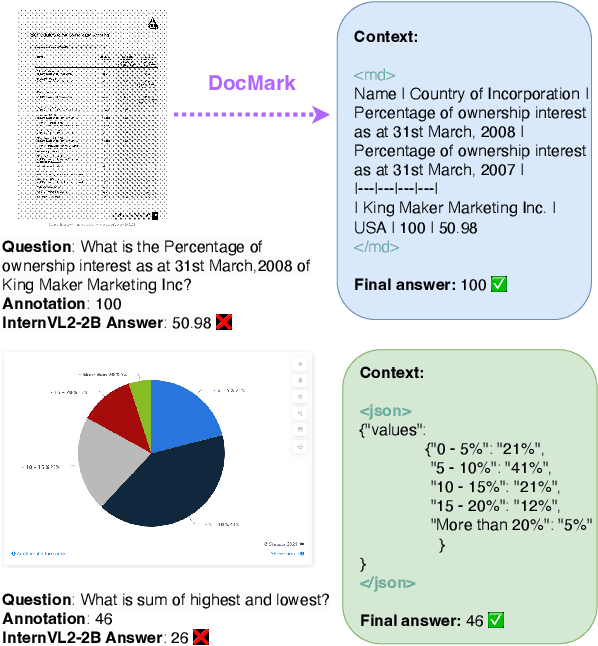

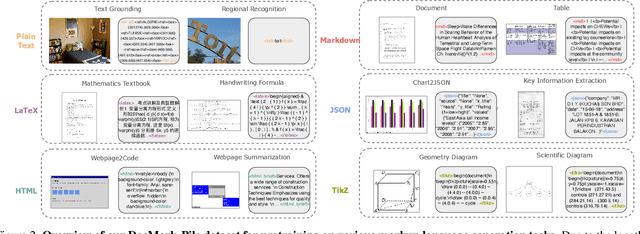
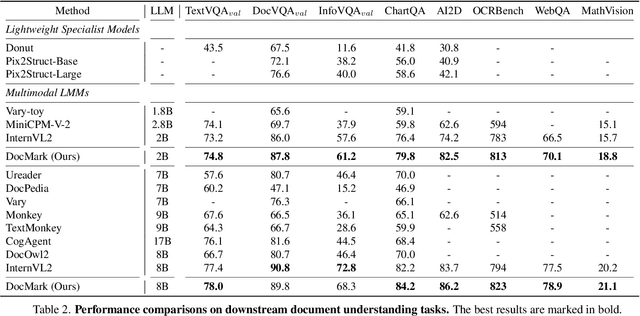
Abstract:Visual Document Understanding has become essential with the increase of text-rich visual content. This field poses significant challenges due to the need for effective integration of visual perception and textual comprehension, particularly across diverse document types with complex layouts. Moreover, existing fine-tuning datasets for this domain often fall short in providing the detailed contextual information for robust understanding, leading to hallucinations and limited comprehension of spatial relationships among visual elements. To address these challenges, we propose an innovative pipeline that utilizes adaptive generation of markup languages, such as Markdown, JSON, HTML, and TiKZ, to build highly structured document representations and deliver contextually-grounded responses. We introduce two fine-grained structured datasets: DocMark-Pile, comprising approximately 3.8M pretraining data pairs for document parsing, and DocMark-Instruct, featuring 624k fine-tuning data annotations for grounded instruction following. Extensive experiments demonstrate that our proposed model significantly outperforms existing state-of-theart MLLMs across a range of visual document understanding benchmarks, facilitating advanced reasoning and comprehension capabilities in complex visual scenarios. Our code and models are released at https://github. com/Euphoria16/DocMark.
WebGen-Bench: Evaluating LLMs on Generating Interactive and Functional Websites from Scratch
May 06, 2025
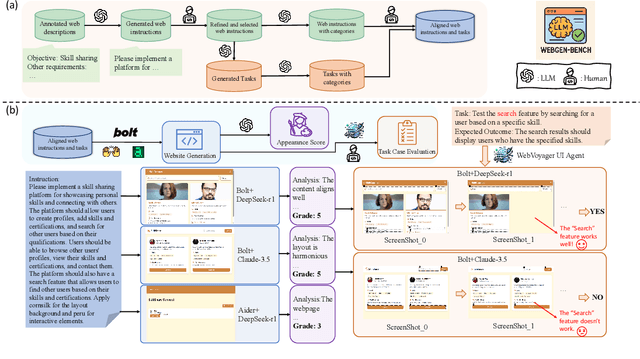
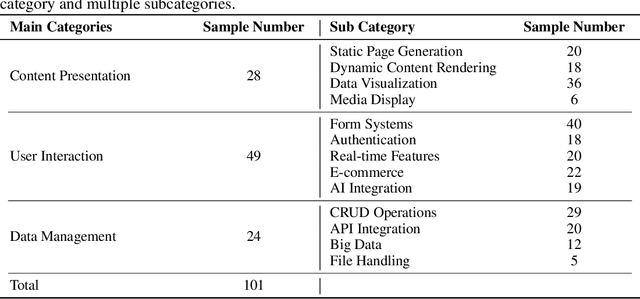
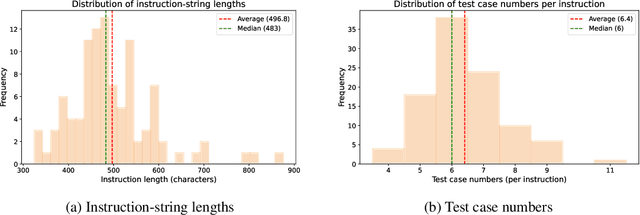
Abstract:LLM-based agents have demonstrated great potential in generating and managing code within complex codebases. In this paper, we introduce WebGen-Bench, a novel benchmark designed to measure an LLM-based agent's ability to create multi-file website codebases from scratch. It contains diverse instructions for website generation, created through the combined efforts of human annotators and GPT-4o. These instructions span three major categories and thirteen minor categories, encompassing nearly all important types of web applications. To assess the quality of the generated websites, we use GPT-4o to generate test cases targeting each functionality described in the instructions, and then manually filter, adjust, and organize them to ensure accuracy, resulting in 647 test cases. Each test case specifies an operation to be performed on the website and the expected result after the operation. To automate testing and improve reproducibility, we employ a powerful web-navigation agent to execute tests on the generated websites and determine whether the observed responses align with the expected results. We evaluate three high-performance code-agent frameworks, Bolt.diy, OpenHands, and Aider, using multiple proprietary and open-source LLMs as engines. The best-performing combination, Bolt.diy powered by DeepSeek-R1, achieves only 27.8\% accuracy on the test cases, highlighting the challenging nature of our benchmark. Additionally, we construct WebGen-Instruct, a training set consisting of 6,667 website-generation instructions. Training Qwen2.5-Coder-32B-Instruct on Bolt.diy trajectories generated from a subset of this training set achieves an accuracy of 38.2\%, surpassing the performance of the best proprietary model.
GenieBlue: Integrating both Linguistic and Multimodal Capabilities for Large Language Models on Mobile Devices
Mar 08, 2025Abstract:Recent advancements in Multimodal Large Language Models (MLLMs) have enabled their deployment on mobile devices. However, challenges persist in maintaining strong language capabilities and ensuring hardware compatibility, both of which are crucial for user experience and practical deployment efficiency. In our deployment process, we observe that existing MLLMs often face performance degradation on pure language tasks, and the current NPU platforms on smartphones do not support the MoE architecture, which is commonly used to preserve pure language capabilities during multimodal training. To address these issues, we systematically analyze methods to maintain pure language capabilities during the training of MLLMs, focusing on both training data and model architecture aspects. Based on these analyses, we propose GenieBlue, an efficient MLLM structural design that integrates both linguistic and multimodal capabilities for LLMs on mobile devices. GenieBlue freezes the original LLM parameters during MLLM training to maintain pure language capabilities. It acquires multimodal capabilities by duplicating specific transformer blocks for full fine-tuning and integrating lightweight LoRA modules. This approach preserves language capabilities while achieving comparable multimodal performance through extensive training. Deployed on smartphone NPUs, GenieBlue demonstrates efficiency and practicality for applications on mobile devices.
Chimera: Improving Generalist Model with Domain-Specific Experts
Dec 08, 2024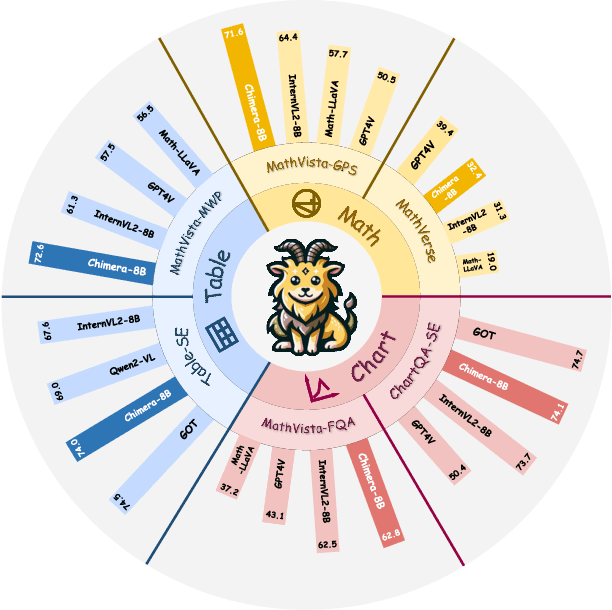
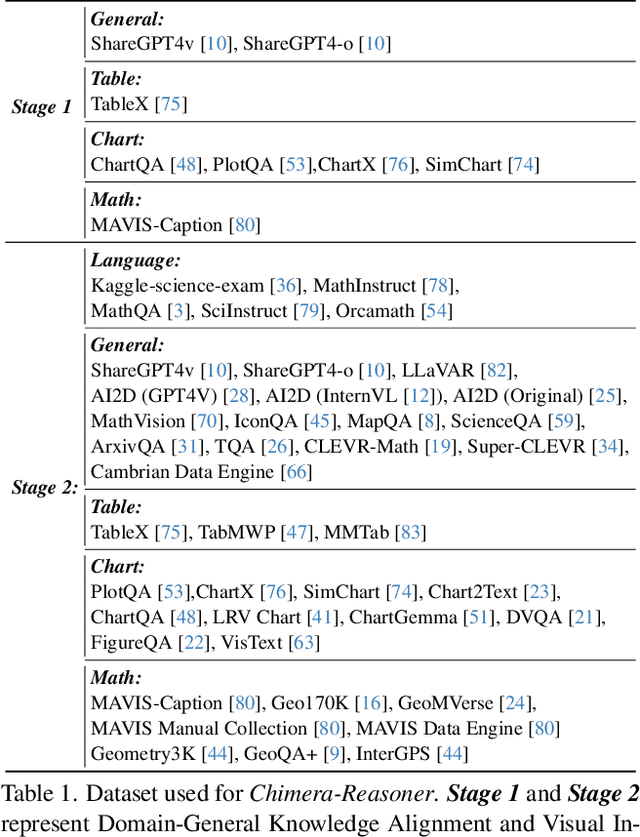
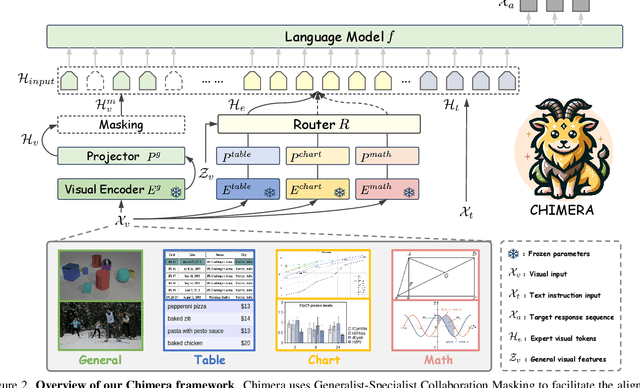
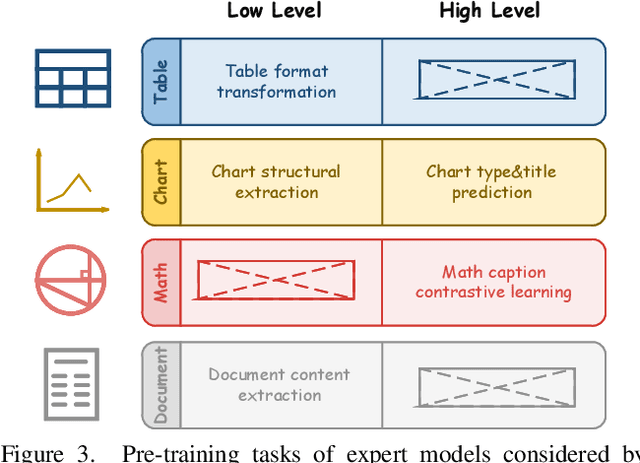
Abstract:Recent advancements in Large Multi-modal Models (LMMs) underscore the importance of scaling by increasing image-text paired data, achieving impressive performance on general tasks. Despite their effectiveness in broad applications, generalist models are primarily trained on web-scale datasets dominated by natural images, resulting in the sacrifice of specialized capabilities for domain-specific tasks that require extensive domain prior knowledge. Moreover, directly integrating expert models tailored for specific domains is challenging due to the representational gap and imbalanced optimization between the generalist model and experts. To address these challenges, we introduce Chimera, a scalable and low-cost multi-modal pipeline designed to boost the ability of existing LMMs with domain-specific experts. Specifically, we design a progressive training strategy to integrate features from expert models into the input of a generalist LMM. To address the imbalanced optimization caused by the well-aligned general visual encoder, we introduce a novel Generalist-Specialist Collaboration Masking (GSCM) mechanism. This results in a versatile model that excels across the chart, table, math, and document domains, achieving state-of-the-art performance on multi-modal reasoning and visual content extraction tasks, both of which are challenging tasks for assessing existing LMMs.
 Add to Chrome
Add to Chrome Add to Firefox
Add to Firefox Add to Edge
Add to Edge